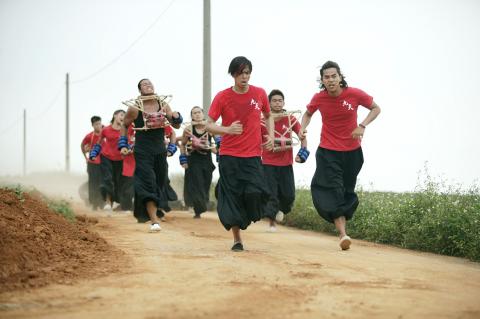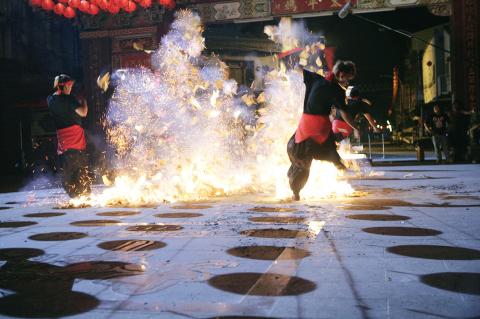Seasoned television director Fung Kai’s (馮凱) Din Tao: Leader of the Parade (陣頭) is edifying for those not familiar with dintao, a type of traditional temple performance troupe. For everyone else, the film is an overly long formulaic exercise in banality.
Performer Allen Ko (柯有倫) plays A-tai, a young man who dreams about becoming a rocker in the US. He quits school in Taipei and returns to his Taichung hometown before following his heart’s desire.
A-tai has never been on good terms with his father, Uncle Da (Chen Po-cheng, better know as A-hsi, 阿西), who runs a dintao troupe. The father and son never make an effort to understand one another, and quarrel each time they meet.

Photo Courtesy of IFILM
But Uncle Da has other things to worry about. While his company struggles to make ends meet, long-standing rival Wu Cheng (Liao Chun, 廖峻) and his troupe meet with success and popularity.
Irked by Wu’s arrogance, A-tai decides to take the troupe’s demoralized members on a countrywide walk in search of inspiration to revamp the traditional folk art form.
The movie was inspired by the Jyou-Tian Folk Drum and Arts Group (九天民俗技藝團). Founded in 1995 by drummer Shue Chen-rong (許振榮), the Taichung-based troupe is credited with updating folk drumming, acrobatics and traditional dances for contemporary audiences and introducing the performances to international audiences by attending art festivals abroad. The troupe’s last sojourn was a seven-day, 250km-long ultra marathon across the Sahara Desert in Egypt in October, completed while its members carried a 17kg statue of the deity Nezha (哪吒).

Photo Courtesy of IFILM
The movie has a certain degree of authenticity in its depiction of dintao as an extended family in which the troupe’s leader is more like a father figure to the group’s young members, most of whom are dropouts. It also fares well in the acting department, anchored by veteran actors A-hsi, Liao Chun and Samantha Ko (柯淑勤). Pop idol Alien Huang, better known as Hsiao-kuei (小鬼), deserves special mention for his dintao performances. Yet the movie is little more than a glorified television drama, replete with cliches, stereotypical characters and an uneven narrative.
As Taiwanese grassroots culture is a mainstay of local productions of late, movies like Din Tao: Leader of the Parade have come one after another, following what is believed to be a winning formula that blends traditional practices with modern elements. However, without a good story line and emotional depth to sustain it, the enthusiasm for traditional cultural doesn’t last the distance.

Photo Courtesy of IFILM

April 7 to April 13 After spending over two years with the Republic of China (ROC) Army, A-Mei (阿美) boarded a ship in April 1947 bound for Taiwan. But instead of walking on board with his comrades, his roughly 5-tonne body was lifted using a cargo net. He wasn’t the only elephant; A-Lan (阿蘭) and A-Pei (阿沛) were also on board. The trio had been through hell since they’d been captured by the Japanese Army in Myanmar to transport supplies during World War II. The pachyderms were seized by the ROC New 1st Army’s 30th Division in January 1945, serving

The People’s Republic of China (PRC) last week offered us a glimpse of the violence it plans against Taiwan, with two days of blockade drills conducted around the nation and live-fire exercises not far away in the East China Sea. The PRC said it had practiced hitting “simulated targets of key ports and energy facilities.” Taiwan confirmed on Thursday that PRC Coast Guard ships were directed by the its Eastern Theater Command, meaning that they are assumed to be military assets in a confrontation. Because of this, the number of assets available to the PRC navy is far, far bigger

The 1990s were a turbulent time for the Chinese Nationalist Party’s (KMT) patronage factions. For a look at how they formed, check out the March 2 “Deep Dives.” In the boom years of the 1980s and 1990s the factions amassed fortunes from corruption, access to the levers of local government and prime access to property. They also moved into industries like construction and the gravel business, devastating river ecosystems while the governments they controlled looked the other way. By this period, the factions had largely carved out geographical feifdoms in the local jurisdictions the national KMT restrained them to. For example,

The remains of this Japanese-era trail designed to protect the camphor industry make for a scenic day-hike, a fascinating overnight hike or a challenging multi-day adventure Maolin District (茂林) in Kaohsiung is well known for beautiful roadside scenery, waterfalls, the annual butterfly migration and indigenous culture. A lesser known but worthwhile destination here lies along the very top of the valley: the Liugui Security Path (六龜警備道). This relic of the Japanese era once isolated the Maolin valley from the outside world but now serves to draw tourists in. The path originally ran for about 50km, but not all of this trail is still easily walkable. The nicest section for a simple day hike is the heavily trafficked southern section above Maolin and Wanshan (萬山) villages. Remains of